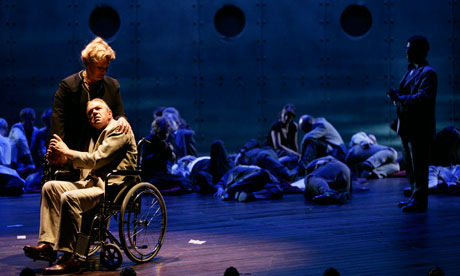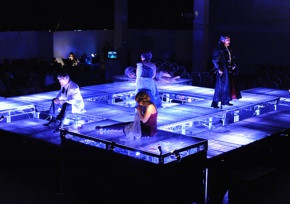It’s no secret to readers of this blog that awol’s location coordinates can occasionally be tracked to an opera house, whether in this city (the Dorothy Chandler Pavilion, or more recently, across the street at Disney Hall), Long Beach, or further afield (which usually means the Metropolitan Opera in New York). Opera has gravitated towards the big stage since early in its evolution for reasons cultural and political, as well as musical and theatrical. Opera is always big, even when the production is relatively small, because the themes, ideas, motives, and emotions are amplified and played out with a richness, intensity and scale rarely possible in legitimate theatre (or musical for that matter) or in other media. (There are exceptions — plays or even films which, in their dramatic scope, structure, texture and emotional resonance, are latently operatic. Tennessee Williams’ A Streetcar Named Desire – recently seen in the Los Angeles Opera’s staging of the Previn/Litell opera – is almost a textbook example of this. Conversely, there are operas that have a ‘cinematic’ sweep – e.g., Don Carlo.)
Mark Swed had a number of points to make (or un-make as it seemed) in his screed in last Sunday’s (June 29) Los Angeles Times, though it was difficult to sort them out through the contradictions and distortions (and, it would appear, an anti-union bent). The main point that seemed to come across (if you could get past his preoccupation with Met Director Peter Gelb’s travails) was that opera, in its transposition and distribution across a number of different venues and media platforms, was becoming what we might call a ‘big, hot mess.’
Well yeah – I guess so. Isn’t that why we’re still going? I’ll always be a sucker for the Met’s Zeffirelli production of Puccini’s La Bohème; but I’m not necessarily going out of my way to see the umpteenth production of Bizet’s Carmen or even Mozart’s Don Giovanni (a favorite). The best operas endure, but the conversation changes. We sing the same arias – but with a different vocabulary (key, register, etc.), conditioned by the most elemental social, economic, environmental factors as well as culture and technology. We see and hear with different eyes and ears, and what inspires us theatrically changes constantly. No – opera is very much alive – perhaps more so than it’s been in a couple of decades. And we really don’t need to worry about it getting bigger or smaller, migrating to screens, non-theatrical venues, or even hybridizing amongst other forms or formats and media. (We see evidence of this in recent dance, performance art and alternative musical performance.) This is all part and function of its evolution as an art form; and we need to recognize and embrace it, even as we’re blown away for the zillionth time by a Met Bohème or the gypsy ballet in Carmen or a trio in Così.
Although I have no doubt the Met is seriously gauging the impact of its HD cinema broadcasts in the New York metro area against declining box office receipts in Manhattan (and new productions are always going to need angels to back or simply gift them), neither the Met, nor any other major international opera house is in any danger of disappearing. Which is another thing about the big operatic institutions – whether at the heart of an urban metropolis or on the festival circuit: they’ve been criss-crossing and hybridizing for most of their histories for the simple reason that they’ve always acted globally, crossing international boundaries for talent, inspiration, audiences and creative partners.
Nor is there any danger of the big stage being eclipsed by the big screen, much less the little screen. Among the so-called ‘lively arts,’ opera may or may not be the liveliest, but it’s surely the most intense. What is the notion of ‘great performance’ without the standard of the operatic diva transfigured into that musical demiurge capable of delivering the highest notes and deepest emotions to the ‘angels’ of the topmost balcony? While in theory, the HD broadcast puts you in the theatre’s ‘sweet spot,’ we don’t have quite the same connection – even compared to the back rows or top balconies.
A screen is after all another filter, and a reductive one – with the key distinction that we’re no longer participants. (The theatrical distancing is already there, defined both by the musical form and theatrical conventions.) Nothing matches the live performance for sheer electricity. We’re swept up in the musical moment with a force rarely equalled in other entertainments. The best operas make us both witnesses and participants in the performance. We’re part of the moment, part of the architecture of the performance.
One of the fascinations of The Industry’s and L.A. Dance Project’s joint production of Invisible Cities last year was its exploration of this temporal and spatial architecture alongside an engineered intersection with the virtual/participatory aspects of the operatic experience. The ‘center-stage’ focal points were set in artfully choreographed motion, yet without diluting their transfigurative power. It was a dual micro/macro approach to the medium. It left the proscenium stage for a different kind of ‘big’ or ‘grand,’ sprawling across a swath of Union Station, while performing to an audience scarcely larger than 100 people. (Yet no one in the vicinity would have been unmoved. The ‘balcony angels’ here were the passengers and passers-by at the terminal.)
As opera (like any other art form) reacts and responds to the most urgent ideas, conditions and questions the culture puts before us, its conventions must inevitably be challenged, flexed and pressed to the furthest edge. The Industry is just one company exploring this terrain. There are others – e.g., Beth Morrison Projects, Opera Cabal, Long Beach Opera itself arguably; and many more. It’s a hot messy business, but they’re all vital to the future of the art form, vital in fact to the big stage, the biggest houses, because that’s usually where the largest, most central, and most far-reaching conversations take place – or in any case, where they should.
Which brings us to Gelb’s poor decision to cancel the HD simulcast of John Adams’ The Death of Klinghoffer. The decision may be something of a wash. The opera remains scheduled for its full run; and the controversy may even fill more seats in the house. But it sends a bad message if Gelb is serious about reaching out to new audiences (including those once expected to access Met performances via the simulcasts). That Klinghoffer should even be considered controversial some 23 years after its premiere is simply ludicrous. ADL-fed claims that it might encourage anti-semitism are absurd. This is really belated censorship, undoubtedly embraced by apologists for the Netanyahu regime. One could only hope it spurs further discussion about Zionism in overdrive. (We don’t hear much protest from the ADL about aggressive Israeli settlement building in the West Bank or squeezing Palestinian residents out of East Jerusalem.) But the larger point is simply that the Met should embrace whatever might remain controversial about this opera; and should be commissioning new operatic works that are even more politically controversial. (It frankly amazes me that we haven’t seen operas yet about the Bush administration wars, about Benazir Bhutto and the ISI, about the planetary environmental crises, the digital/cyber-tech explosion and financial melt-down and so much more.)
Yes, it all costs money – all the more reason why the Met and other opera companies (including the Los Angeles Opera) should be forging new creative partnerships, to workshop new operas the same way major Broadway shows are developed. Companies like The Industry, Beth Morrison, et al. are already leading the way. The Industry presented an adventurous “First Take” program of operas-in-progress just last year at the Hammer Museum, including new work by Alexander Vassos, Ellen Reid, the legendary Pauline Oliveiros and Mohammed Fairouz. Swed also failed to note that, despite Gelb’s handwringing over labor negotiations and the cinematic cannibalization of the Met’s ‘metro’ audience, the English companies referenced in the Guardian article – the Royal Opera and English National Opera – are thriving, as are a number of other major European houses. And while Swed is complaining about union labor overhead (does he have any clue how much it costs to live in New York?—or for that matter any other big city?), I’ll just get a bit political here and say that the flattening of philanthropic donations and production underwriting is one more indicator that taxes on the very wealthy should be dramatically increased. It’s what the one-percent would call “incentivizing.”
This is about where the standards and requirements of high culture meet the realities of mass entertainment. Opera (like so many manifestations of ‘high culture’) will never be for everyone – nor is it necessarily an ‘everyday’ thing even for those of us who are passionate about it. But in a 24/7 mass culture/media/entertainment environment, you better give people something to talk about.




